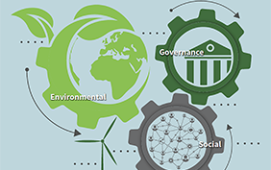
The ESG data sourcing challenge facing financial institutions has largely abated, but data quality remains an issue that even artificial intelligence (AI) can’t yet remedy.
That was one of the key messages from the opening presentation at A-Team Group’s third annual ESG Data and Tech Summit London, in which Nirav Shah, senior executive director, quant and ESG technology at JP Morgan Asset Management, painted a picture of an improving but still evolving data landscape for sustainability-focused institutions.
At the Practitioner Innovation Keynote Fireside Chat, whose theme was “Leveraging AI for ESG Insights”, Shah said that many aspects of the ESG space had begun to mature. However, other factors were at risk of becoming problematic as sustainability becomes more closely integrated into firms’ workflows.‘Patchy’ Quality
Speaking to Mark Davies, partner and EMEA lead at data management provider Element 22, Shah paid close attention to data quality, which he said remains “patchy”. Drawing particular attention to the importance of data lineage and traceability, he said that without good quality data, ESG processes can’t function optimally.
When asked if AI offered a solution to the “quality gap”, Shah said he thought it as unlikely for the time being. AI is helping to solve the “content gap”, by finding themes, patterns and insights in datasets, he said, but it was yet to show it could help improve data quality. Large language models (LLMs), of which Generative AI (GenAI) is an example, would be especially lacking in this regard because they are not deterministic and every time a user asks it a question, it gives a different answer.
Getting Better
Shah was positive about improvements to data sourcing. He said that “basic” ESG data, such as emissions and climate information, were now relatively easy to obtain. Nevertheless, the picture was less rosy for specific sustainability factors that are emerging in importance. For instance, Davies noted that only 30 per cent of portfolio companies were reporting gender pay gap statistics and only half that proportion were disclosing on their water emissions performance.
That was posing a problem especially as firms such as JPMorgan were using fewer aggregated metrics such scores and ratings and instead were focusing on net-zero transition progress, which requires granular raw data. However, the downside is being balanced by more companies reporting Scope 3 data, thanks to the creation of new and innovative datasets.
Shah said the perception of ESG was changing from being part of firms’ investment theses to being an integral element of their overall risk strategies. In this regard, integration of sustainability data should not be treated any differently than other financial risk data.
Organisations that did otherwise often wasted time creating processes that “are ancillary to their core operations” to the neglect of data quality oversight. It would also undermine the ability to cross-reference the information with other financial datasets.
AI Potential
After 12 months in which the financial sector – and others besides – had been dominated by speculation about the opportunities offered by AI, it was unsurprising that the ESG Data and Tech Summit London devoted considerable time to the theme. (A-Team Group will focus on the importance of this far-reaching new technology at its AI in Capital Markets Summit London on June 20.)
Shah said applications such as machine learning were bringing “fundamental change”. But he cautioned that the use cases for GenAI were yet to be fully understood and that the benefits offered so far are very expensive to scale.
An audience poll echoed that sentiment. At the top of respondents’ answers to the question “What’s your biggest challenges frustrations when dealing with ESG and AI?” was proof of concept and the cost to scale.
Like many of the speakers over the course of the summit, Shah said it was important to keep humans in any workflows that utilise AI capabilities. LLMs may be able to pull in more data than established methods but it will still needs analysts to view it outputs for the foreseeable future.
Subscribe to our newsletter





